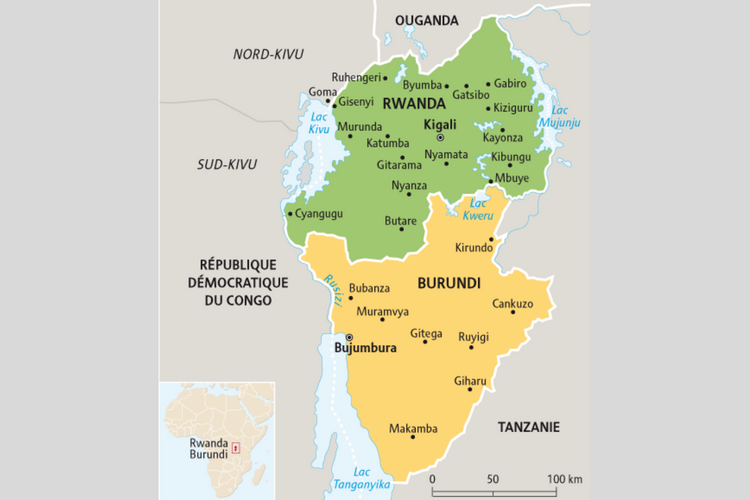When the Germans came to colonize the region they made many false assumptions that created the tribal conflicts. German settlers assumed the Tutsi wielded power over the Hutu because they owned a lot of cattle and were believed to be taller with a more commanding statue. As a result Germans selected Tutsis for positions of authority in the colonial administration.
In April 1916, the Belgians invaded Ruanda-Urundi and occupied the territory for the remainder of World War I. They saw the region as a way of expanding their economic power in Europe but they also wanted parts of Angola they were not able to acquire during the Scramble. After the war, Belgium proposed a three way deal in which Britain would take over Ruanda-Urundi from Belgium; Belgium would acquire the Congo south bank from Portugal and Portugal would be given the southeast corner of German East Africa that Britain had conquered. But the deal fell through after Portugal failed to cede the Congo south bank to Belgium.
 After this, Ruanda-Urundi were treated as extensions of the Belgian Congo. Belgians viewed the populations of Ruanda-Urundi as vital labor sources for copper mines in Katanga. By 1930, about 2% of the male population in Ruanda-Urundi was working in the Congo, mostly in Katanga. The fertile land of Ruanda-Urundi made it the agriculture base for the Congo. They grew beans, sweet potatoes, cassava, potatoes and coffee. The Belgians also introduced compulsory unpaid labor as a form of tax for the cultivation of crops and the transport of produce to the markets. Coffee was introduced in 1925 and by 1929; Ruanda-Urundi was exporting about 50 tonnes which increased to 2,000 tonnes by 1937.
After this, Ruanda-Urundi were treated as extensions of the Belgian Congo. Belgians viewed the populations of Ruanda-Urundi as vital labor sources for copper mines in Katanga. By 1930, about 2% of the male population in Ruanda-Urundi was working in the Congo, mostly in Katanga. The fertile land of Ruanda-Urundi made it the agriculture base for the Congo. They grew beans, sweet potatoes, cassava, potatoes and coffee. The Belgians also introduced compulsory unpaid labor as a form of tax for the cultivation of crops and the transport of produce to the markets. Coffee was introduced in 1925 and by 1929; Ruanda-Urundi was exporting about 50 tonnes which increased to 2,000 tonnes by 1937.
In the 1930s, it became clearer that the colonial authorities favored the Tutsis over the Hutus. The Belgians continued to perpetuate the stereotype of tall slender Tutsis and short stocky Hutus. In 1926, they introduced an identity card which by law had to specify which tribe someone belonged to. However, due to years of intermarriage and migration the stereotypes could not be used to identify all people. So they introduced a formula: those with 10 cows or more were classified as Tutsi and those with less as Hutu. All the decisions made during this colonial era can be directly linked to the problems Rwanda faced later.
The Catholic Church
In Rwanda and Burundi, like in most countries in Africa, most schools during the colonial period were run my missionaries who regarded education as a primary means of evangelizing to spread their Christian faith. In the 1930s, the Catholic Bishop, Leon Classe negotiated a school contract that would keep the Belgian colonial administration out of schools and allow the Catholic Church to assume responsibility for the entire education system. In turn, the Catholic Church received 47 francs per student and 600 francs per teacher. The church perpetuated the government’s preference of Tutsis over Hutus setting the groundwork for the resentment that resulted in the genocide. The Catholic Church chose Tutsis over Hutus and all government positions were to be reserved for the Tutsis. Bishop Classe believed that Hutus still needed just enough education so they could work in mines and industry. Until 1956, the only way a Hutu could receive higher education was if they went to a Catholic seminary to become a Priest.
In spite of the church’s role in oppressing Hutus, the first Rwandese to receive a kind of University degree was Anastase Makuza who graduated from the Centre Universitaire of Kisantu (Congo) in 1955 with a degree in political and administrative sciences. His application for a post to work in government and for the Institut pour la Recherche Scientifique en Afrique Centrale was turned down because he was not Tutsi. He finally landed a job as a typist in Kibuye. As more Hutu became educated they found it frustrating that they could not secure employment just because of their tribal heritage. In March 1957, the Hutu published the Hutu Manifesto, a document which challenged the prevailing social and economic system in Rwanda at the time.
Rwanda and Burundi
When the Belgian government agreed to hold democratic municipal elections in Ruanda-Urundi in 1960, the Hutu majority elected Hutu representatives which ended the Tutsi ruling privileges. The Belgian effort to create an independent Ruanda-Urundi with Tutsi-Hutu power sharing failed. At the urging of the United Nations, the Belgian government divided Ruanda-Urundi into two separate countries, Rwanda and Burundi.





One response to “Ethnic Hierarchy in Ruanda- Urundi from 1890”
Most people are not well schooled in archaeological anthropology of South Asia most Hindus consider themselves to be so-called Indo – Aryans i.e. , Euro-Caucasians but real history reveals the truth about the these Neanderthal contanminated groups for example a large majority of the early invaders ( circa 1050 BCE ) of India were Hittites/Elamites/Kassite none whom were Caucasians ( though they had assimilated many a Caucasoids from the surrounding peoples before the great Caucasian migration out of Southern Russia in the 11th century BCE ) !!!!!! Hindu nationalists have always been deceived that’s how Adolf Hitler convinced many of them to fight for Nazi Germany in the Soviet Union during WWII !!!!!!!!!!!!!!!!